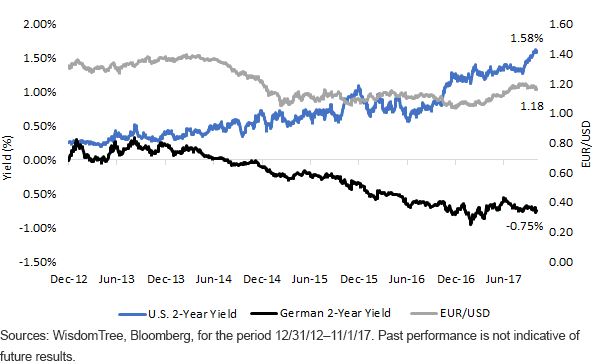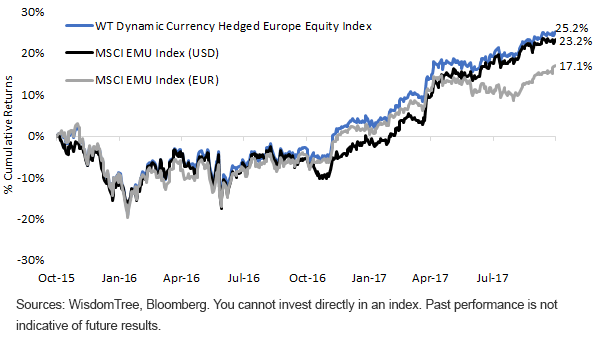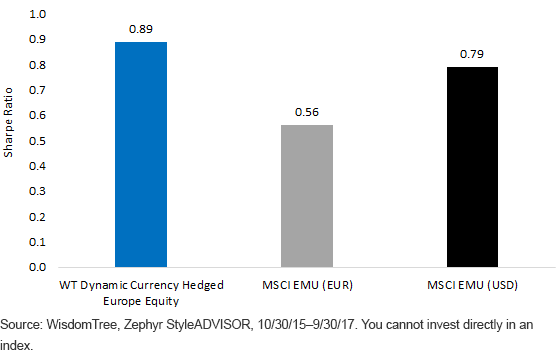The ECB Is Telling Us Something; Our Dynamic Hedge Is Listening


Mario Draghi and the European Central Bank (ECB) provided some much-anticipated clarity on October 26 about the future of its asset purchase program following the governing council’s monetary policy meeting. We recently discussed the details of the ECB announcement here. In short, the planned taper had been well telegraphed ahead of time: the ECB will maintain accommodative financial conditions for the foreseeable future.
A low-rate environment coupled with an accelerating economic recovery provides a supportive backdrop for European equities, but the case for the direction of the currency is a bit more mixed. A review of how a dynamically hedged approach has responded to certain currency signals in recent history may provide some insights into how investors can approach a long-run strategic allocation to international investing.
Currency Signals
The ECB’s latest update on quantitative easing likely shelves any serious rate hike discussion until 2019, a plan that may help address one of the governing council’s concerns over the future of the recovery: a strengthening euro,1 up 11% relative to the dollar year-to-date.2 Interest rate differentials are a key driver of short-term currency movements. The “carry trade” leads investors to sell the lower-yielding currency (the euro) and buy the higher-yielding currency (the dollar) to earn the “carry” on the differential, leading to a relative appreciation of the higher-yielding currency. Following the October 26 announcement, the euro has dropped as much as 3.5% from its September 8 high on the year.3
EUR/USD and 2-Year Sovereign Debt Yields

In November 2015, WisdomTree launched a suite of dynamic currency-hedged Indexes with three signals, each with a one-third weight contributing to the hedge ratio, that are screened monthly: momentum, value and interest rate differentials. Since the inception of the WisdomTree Dynamic Currency Hedged Europe Equity Index in November 2015, a strategy designed to dial exposure to the euro up or down depending on the three signals, U.S. short-term rates have been higher than eurozone short-term rates. The above chart of 2-year sovereign yields in the U.S. and Germany shows how short-term interest rate differentials are related to why that rate signal applies a hedge to the euro currently.
The interest rate differential signal of the dynamic hedge will keep the Index at minimum at a one-third hedge for the foreseeable future.
The other two signals included in the dynamic model are valuations and momentum. The value signal shows the euro as undervalued, and that hedge ratio dropped to zero earlier this year. So in short, interest rates and valuations are pulling in opposite directions. The deciding factor is just raw price momentum, which captures changes in sentiment. Largely, the euro has been appreciating, so that signal lowered the aggregate hedge ratio in June to 33.3%.
With less than a 50% hedge for the past five months during a strong euro environment, the dynamic hedge is doing exactly what would be expected: dialing up the exposure to the currency based on the quick to respond momentum signal and reaping some of the tailwinds of the currency. Over the short two-year live history, a period where the euro has appreciated nearly 5% versus the dollar, the WisdomTree Index has been able to maintain a 200-basis point (bps) outperformance advantage over the MSCI EMU Index in dollars, and an over 800-bps outperformance over the MSCI EMU Index in euros.4
Index Cumulative Total Returns (10/30/15–10/30/17)

The Goal: Improved Risk/Return Characteristics
There is a compelling investment case in European equities grounded in relative valuations, a slew of positive macroeconomic indicators and sustained easy monetary policy conditions. The key for international investors then becomes tapping this market while minimizing the impact of currency fluctuations that may result in significant moves in either direction for protracted periods. For most investors that do not see themselves as expert currency managers, making a call on the next double-digit move in the euro is a coin flip.
Sharpe Ratio across Indexes since Inception

At WisdomTree, we aim to construct unique Indexes that can improve the investor experience beyond the traditional market cap-weighted strategies. The approach for the WisdomTree Dynamic Currency Hedged Europe Equity Index was no different: combine a fundamentals-based Dividend Stream®-weighted strategy with a dynamic currency hedge to produce a valuation-sensitive index with improved risk and return characteristics over the long run.
The results thus far? Improved risk-adjusted returns, as measured by Sharpe ratios, were above not only the unhedged MSCI EMU Index but also the MSCI EMU Index in local currency. With European equities offering a great opportunity at present, this dynamic currency-hedged approach may be worth considering for those seeking equity exposure while relying on a rules-based approach to reduce the currency drag.
1Source: Claire Jones, “ECB Minutes Reveal Concern over Euro Strength,” Financial Times, 8/17/17.
2Source: Bloomberg, for the period 12/30/16–11/1/17.
3Source: Bloomberg, low point on October 27.


